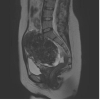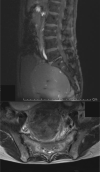Female detrusor underactivity: Two uterine leiomyoma cases
- PMID: 33426487
- PMCID: PMC7784732
- DOI: 10.1002/iju5.12223
Female detrusor underactivity: Two uterine leiomyoma cases
Abstract
Introduction: Female urinary retention is rare.
Case presentation: Case 1, a 35-year-old nulliparous woman, and case 2, a 47-year-old nulliparous woman, had transient urinary retention. A urodynamics revealed increased bladder sensation in case 1 and detrusor underactivity with a large post-void residual in cases 1 and 2. Both women had a uterine leiomyoma of >10 cm in diameter. Soon after extraction of the tumor, retention episodes disappeared completely in case 1.
Conclusion: Although rare, uterine leiomyoma should be listed as a cause of female detrusor underactivity.
Keywords: detrusor underactivity; leiomyoma; urinary retention; urodynamics; uterus.
© 2020 The Authors. IJU Case Reports published by John Wiley & Sons Australia, Ltd on behalf of the Japanese Urological Association.
Conflict of interest statement
The authors declare no conflict of interest.
Figures



Similar articles
-
Detrusor underactivity and the underactive bladder: a new clinical entity? A review of current terminology, definitions, epidemiology, aetiology, and diagnosis.Eur Urol. 2014 Feb;65(2):389-98. doi: 10.1016/j.eururo.2013.10.015. Epub 2013 Oct 26. Eur Urol. 2014. PMID: 24184024 Review.
-
Urodynamics of men with urinary retention.Int J Urol. 2017 Sep;24(9):703-707. doi: 10.1111/iju.13395. Epub 2017 Jul 7. Int J Urol. 2017. PMID: 28687026
-
Leiomyoma of the bladder presenting as acute urinary retention in a female patient: urodynamic analysis of lower urinary tract symptom; a case report.BMC Urol. 2010 Aug 4;10:13. doi: 10.1186/1471-2490-10-13. BMC Urol. 2010. PMID: 20684762 Free PMC article.
-
A Prediction Model of Detrusor Underactivity Based on Symptoms and Noninvasive Test Parameters in Men with Lower Urinary Tract Symptoms: An Analysis of a Large Group of Patients undergoing Pressure-Flow Studies.J Urol. 2020 Apr;203(4):779-785. doi: 10.1097/JU.0000000000000616. Epub 2019 Oct 24. J Urol. 2020. PMID: 31647388
-
Detrusor underactivity in men with lower urinary tract symptoms/benign prostatic obstruction: characterization and potential impact on indications for surgical treatment of the prostate.Curr Opin Urol. 2016 Jan;26(1):3-10. doi: 10.1097/MOU.0000000000000246. Curr Opin Urol. 2016. PMID: 26574876 Review.
Cited by
-
Female Urinary Retention Progressing to Possible Multiple System Atrophy-cerebellar Form after 12 Years.Intern Med. 2022 Dec 1;61(23):3599-3604. doi: 10.2169/internalmedicine.8724-21. Epub 2022 May 14. Intern Med. 2022. PMID: 35569977 Free PMC article.
-
A giant calculus within urethral diverticulum causing urinary retention in an uncommunicative woman.IJU Case Rep. 2022 Mar 18;5(3):211-213. doi: 10.1002/iju5.12435. eCollection 2022 May. IJU Case Rep. 2022. PMID: 35509777 Free PMC article.
References
-
- Baird DD, Dunson DB, Hill MC, Cousins D, Schectman JM. High cumulative incidence of uterine leiomyoma in black and white women: ultrasound evidence. Am. J. Obstet. Gynecol. 2003; 188: 100–7. - PubMed
-
- Wu CQ, Lefebvre G, Frecker H, Husslein H. Urinary retention and uterine leiomyomas: a case series and systematic review of the literature. Int. Urogynecol. J. 2015; 26: 1277–84. - PubMed
-
- Dagur G, Suh Y, Warren K, Singh N, Fitzgerald J, Khan SA. Urological complications of uterine leiomyoma: a review of literature. Int. Urol. Nephrol. 2016; 48: 941–8. - PubMed
-
- Kansu‐Celik H, Evliyaoglu O, Karakaya BK, Tarlan N, Ozel S, Engin‐Ustun Y. Two cases of acute urinary retention caused by large cervical leiomyoma with review of literature. J. Exp. Ther. Oncol. 2019; 13: 41–3. - PubMed
Publication types
LinkOut - more resources
Full Text Sources
